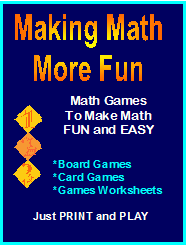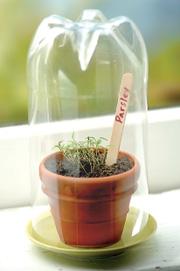|
Bingo Blitz
By - Abbie Artley
Subject - Math
Grade Level - 3-4
Overview: Students will do math problems and find answers on
their bingo cards. I use this game for decimal computation, but it
can be used for just about anything!
Objective: Bingo Blitz is a fun way to review a variety of math
concepts.
Materials:
*Bingo Cards and Answer List (directions for making are below)
*Beans (or other items to use for markers)
*Pencils (one for each student)
*Overhead projector or chalkboard
*Prizes (optional)
Bingo Blitz can be used in many areas of mathematics. I use it to
sharpen my students' decimal addition and subtraction skills. The
following instructions are based on this concept, but it can easily
be adapted for many different math ideas.
Instructions for making Bingo Cards and Answer List:
1. Draw a grid consisting of 25 squares. The squares need to be big
enough for the students to write decimal numbers. You can fit 4
grids on one sheet of paper, or you can draw two grids and leave
some room for students to work out the problems.
2. Develop about 50 decimal sum and difference problems. You can
find these in workbooks and textbooks, or you can make up your own!
Write the answers on an overhead transparency. The students will
copy answers randomly on their bingo cards. Write or type the
problems AND ANSWERS on paper and cut the problems apart. Put the
problems in a paper bag or hat.
3. Pass out bingo cards and beans to each student. One handful of
beans is plenty! Make sure students have a writing utensil.
4. Put the answer list on the overhead projector or write the
answers on the chalkboard. Have students RANDOMLY write answers in
squares on their boards. Do one board at a time. You can use the
same board over and over or copy new numbers for each game.
5. Pull out a problem from the bag or hat and write it on the
overhead or chalkboard. Students will use scratch paper (or their
bingo cards) to work the problem. If the answer they get is on their
card, they get to put a bean on that square.
Note: You may set a time limit or have them use mental math. these
details are up to the individual teacher.
6. When a student has a bingo, have him/her read the answers, and
you can check for accuracy.
There are many ways in which teachers can use this game:
vocabulary review, geometry concepts, basic computation facts, and
even algebra and calculus! That's why I love using this game- it's
very versatile.
E-Mail Abbie!
Source:
The
LessonPlans Page |
Now It's Fall
In this lesson plan for the picture book Now It's Fall by Lois
Lenski, students will learn about autumn and different objects and
events associated with this special season.

 Spring in a Bottle Spring in a Bottle
If it feels like spring's taking too long to
sprout, liven up a winter windowsill by making this mini
greenhouse -- a recycled take on a cloche, traditionally used
outdoors to protect early plantings.
Museum Box
This site provides the tools for users to build up an
argument or
description of an event, person or historical period by
placing items in a
virtual box. Lesson guidance and instructions for use are
available in the
teachers' area.
Electrocity
Electrocity is an online game which involves students
building and managing
their own virtual towns and cities, making important
decisions and learning
about energy generation and environmental management.
|